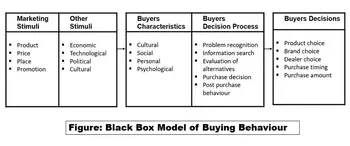Table of Contents:-
- Black Box Model
- Distributive Approach
Black Box Model
Consumers make many buying decisions every day. Most large organisations research consumer buying decisions in great detail to answer the questions about what consumers buy where they buy, how and how much they buy when they buy, and why they buy. Marketers can study actual consumer purchases to determine what, where, and how much they buy. But learning about the whys of consumer buying behaviour is not so easy, the answers are often locked deep within the consumer’s head.
Salespeople know that some prospects buy their services and products after the sales presentation and some prospects do not buy. Salespeople do not know the hidden mental process of prospects (or buyers).
Related Article:- Nature of Marketing
A company that understands how consumers will respond to different product features, prices, and advertising appeals has a great advantage over its competitors. The starting point for understanding buying behaviour is the stimulus-response model of buyer behaviour (as shown in the figure). This figure shows that marketing and other stimuli enter the consumer’s “black box” & produce certain responses.
Marketers must figure out what is in the customer’s black box.
Marketing stimuli consist of the four P’s: product, price, place, & promotion. Other stimuli include major forces and events in the customer’s environment: technological, economic, political, and cultural. All this information enters the customer’s black box, where they are turned into a set of observable customer responses: dealer choice, brand choice, product choice, purchase timing, and purchase amount.
The marketer wants to understand how the stimuli are transformed into responses inside the consumer’s black box, which has two parts. First, the customer’s traits influence how he perceives and reacts to the stimuli. Second, the customer’s decision process itself affects the buyer’s behaviour.
It is assumed that if a salesperson applies a stimulus (or sales presentation), the prospective buyer will respond predictably. However, the candidate may or may not buy the product, which the salesperson is trying to sell. The salesperson should, therefore, understand the psychological aspects of buyer behaviour. Psychological factors of buyer or consumer behaviour include attitude, perception, motivation, and personality behaviour. The study of consumer behaviour helps the salesperson to understand the psychological aspects of selling or why the prospect is buying or not buying the product or service.
Related Article:- Scope of Marketing

Distributive Approach
In the distributive approach, attention is focused on the outcome of consumer behaviour. It is concerned with what people did, where they bought, and what products were involved. The distributive approach in consumer behaviour research starts with the outcome. Consumers are dichotomously classified according to whether or not they have consummated a specified kind of market transaction. Performance rates are then compared for various groups, periods, or situations.
A straightforward illustration is afforded by the following case: A manufacturer wished to test the hypothesis that duck hunters, offered prepaid freight, would buy as many boats directly from the manufacturer as they would from their nearest dealer, with freight charges added to the price.
A small advertisement was placed in a national sportsman’s magazine inviting duck hunters to write for information. Alternate respondents were offered the two propositions. The names of the buyers were obtained from the dealers. The tabulation of the percentages of buyers who received the different propositions conclusively rejected the hypothesis.
The distributive method is not as useful for developing a marketing strategy. The distributive approach is indeed simpler and less costly than other approaches. The approach can also be useful for the analysis of specific purchase situations or to explain past consumer behaviour.
You May Also Like:-
